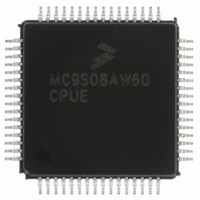MC9S08AW60CPUE Freescale Semiconductor, MC9S08AW60CPUE Datasheet - Page 52

MC9S08AW60CPUE
Manufacturer Part Number
MC9S08AW60CPUE
Description
IC MCU 64K FLASH 64-LQFP
Manufacturer
Freescale Semiconductor
Series
HCS08r
Datasheet
1.MC9S08AW32CFDE.pdf
(324 pages)
Specifications of MC9S08AW60CPUE
Core Processor
HCS08
Core Size
8-Bit
Speed
40MHz
Connectivity
I²C, SCI, SPI
Peripherals
LVD, POR, PWM, WDT
Number Of I /o
54
Program Memory Size
60KB (60K x 8)
Program Memory Type
FLASH
Ram Size
2K x 8
Voltage - Supply (vcc/vdd)
2.7 V ~ 5.5 V
Data Converters
A/D 16x10b
Oscillator Type
Internal
Operating Temperature
-40°C ~ 85°C
Package / Case
64-LQFP
Processor Series
S08AW
Core
HCS08
Data Bus Width
8 bit
Data Ram Size
2 KB
Interface Type
SCI/SPI
Maximum Clock Frequency
40 MHz
Number Of Programmable I/os
54
Number Of Timers
8
Operating Supply Voltage
- 0.3 V to + 5.8 V
Maximum Operating Temperature
+ 85 C
Mounting Style
SMD/SMT
3rd Party Development Tools
EWS08
Development Tools By Supplier
DEMO9S08AW60E
Minimum Operating Temperature
- 40 C
On-chip Adc
16-ch x 10-bit
For Use With
DEMO9S08AW60E - DEMO BOARD FOR MC9S08AW60
Lead Free Status / RoHS Status
Lead free / RoHS Compliant
Eeprom Size
-
Lead Free Status / Rohs Status
Lead free / RoHS Compliant
Available stocks
Company
Part Number
Manufacturer
Quantity
Price
Company:
Part Number:
MC9S08AW60CPUE
Manufacturer:
TDK-LAMBDA
Quantity:
92
Company:
Part Number:
MC9S08AW60CPUE
Manufacturer:
FREESCALE
Quantity:
4 000
Company:
Part Number:
MC9S08AW60CPUE
Manufacturer:
Freescale Semiconductor
Quantity:
10 000
Part Number:
MC9S08AW60CPUE
Manufacturer:
FREESCALE
Quantity:
20 000
Company:
Part Number:
MC9S08AW60CPUER
Manufacturer:
Freescale Semiconductor
Quantity:
10 000
Chapter 4 Memory
4.4.3
The steps for executing any of the commands are listed below. The FCDIV register must be initialized and
any error flags cleared before beginning command execution. The command execution steps are:
A partial command sequence can be aborted manually by writing a 0 to FCBEF any time after the write to
the memory array and before writing the 1 that clears FCBEF and launches the complete command.
Aborting a command in this way sets the FACCERR access error flag which must be cleared before
starting a new command.
A strictly monitored procedure must be obeyed or the command will not be accepted. This minimizes the
possibility of any unintended changes to the FLASH memory contents. The command complete flag
(FCCF) indicates when a command is complete. The command sequence must be completed by clearing
FCBEF to launch the command.
burst programming. The FCDIV register must be initialized before using any FLASH commands. This
only must be done once following a reset.
52
1. Write a data value to an address in the FLASH array. The address and data information from this
2. Write the command code for the desired command to FCMD. The five valid commands are blank
3. Write a 1 to the FCBEF bit in FSTAT to clear FCBEF and launch the command (including its
write is latched into the FLASH interface. This write is a required first step in any command
sequence. For erase and blank check commands, the value of the data is not important. For page
erase commands, the address may be any address in the 512-byte page of FLASH to be erased. For
mass erase and blank check commands, the address can be any address in the FLASH memory.
Whole pages of 512 bytes are the smallest block of FLASH that may be erased. In the 60K version,
there are two instances where the size of a block that is accessible to the user is less than 512 bytes:
the first page following RAM, and the first page following the high page registers. These pages are
overlapped by the RAM and high page registers respectively.
check ($05), byte program ($20), burst program ($25), page erase ($40), and mass erase ($41).
The command code is latched into the command buffer.
address and data information).
Program and Erase Command Execution
Do not program any byte in the FLASH more than once after a successful
erase operation. Reprogramming bits to a byte which is already
programmed is not allowed without first erasing the page in which the byte
resides or mass erasing the entire FLASH memory. Programming without
first erasing may disturb data stored in the FLASH.
Figure 4-3
MC9S08AW60 Data Sheet, Rev 2
is a flowchart for executing all of the commands except for
NOTE
Freescale Semiconductor











